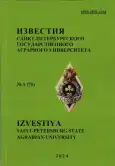Mathematical Model of Electromagnetic Processes at Switching on the Power Transformer of the Power Supply System of the Agro-Industrial Complex at Idle Run
- Authors: Serebryakov A.S.1, Dulepov D.E.1, Osokin V.L.1
-
Affiliations:
- Nizhny Novgorod State Engineering and Economic University
- Issue: No 1(75) (2024)
- Pages: 127-140
- Section: Agroengineering and food technology
- URL: https://journals.rcsi.science/2078-1318/article/view/304745
- DOI: https://doi.org/10.24412/2078-1318-2024-1-127-140
- ID: 304745
Cite item
Full Text
Abstract
At present, the majority of agricultural electricity consumers are supplied from united power systems through networks that are also designed to supply electricity to industrial enterprises, cities, and electrified railway transport. An important element of rural power networks are power transformers of different voltage classes. Many transformer substations in rural power networks operate under difficult conditions and abnormal modes: overloads, operation in underloaded or unbalanced mode, and other emergency and near-emergency modes. To ensure the reliable operation of transformers when designing relay protection against overload currents, internal and external short circuits, and other faults of power transformers and supply lines, it is necessary to take into account the inrush currents when switching on the transformer at idle. The inrush currents at switching are caused by the nonlinearity of the magnetization curve of the ferromagnetic core of the transformer, linking its primary and secondary circuits. The mathematical model of electromagnetic processes in the transformer during its idle switching on includes differential equations of equilibrium of the primary electrical circuit. Transients in an electric circuit with a nonlinear ferromagnetic core are considered on the example of connecting a two-winding transformer in the no-load mode to a sinusoidal supply voltage. The transient mode of transformer connection is considered without taking into account losses in steel and taking these losses into account. The program for calculating the transient process when switching on the transformer at idle without taking into account losses and taking into account losses in steel is made using differential equations in matrix form and in Cauchy form. The methodology presented in the article allows for an accurate analysis of the transient process during transformer idle switching, to take into account the arising magnetizing current surges, their duration, and on the basis of this data to develop technical measures to reduce the negative consequences of these phenomena.
About the authors
A. S. Serebryakov
Nizhny Novgorod State Engineering and Economic University
Author for correspondence.
Email: a.sereb@mail.ru
Doctor of Technical Sciences, Professor Knyagino, Nizhny Novgorod region, Russia
D. E. Dulepov
Nizhny Novgorod State Engineering and Economic University
Email: dulepov.86@mail.ru
Candidate of Technical Sciences, Associate Professor Knyagino, Nizhny Novgorod region, Russia
V. L. Osokin
Nizhny Novgorod State Engineering and Economic University
Email: osokinvl@mail.ru
Candidate of Technical Sciences, Associate Professor Knyagino, Nizhny Novgorod region, Russia
References
- Khalina T. M., Ovsepyan V. A., Bogoutdinov E. R. (2022). ʻAnalysis of the occurrence of magnetic flux surges and magnetizing current when the transformer is turned on at idleʼ // Energeticheskie sistemy, vol. 4, pp. 46–53. (In Russ.). doi: 10.34031/ES.2022.4.005. – EDN PUJPZL.
- Yarymbash D. S., Yarymbash S. T., Kotsur M. I., Divchuk T. E. (2019). ʻModeling of idle mode of the transformer taking into account the effects of hysteresis and eddy currentsʼ // Problemy regional'noj energetiki, vol. 1, pp. 12–21. (In Russ.). doi: 10.5281/zenodo.2650413. – EDN FCAXLN.
- Lurie A. I. (2008). ʻProcess of switching transformers on idle and short circuitʼ // Elektrotekhnika, vol. 2, pp. 2–18. (In Russ.). – EDN LAFKRL.
- Islam M. M., Musil M., Shohan M. A. (2023). ʻA review of modelling techniques of power transformers for digital real-time simulationʼ // J. Eng., pp. 1–16. https://doi.org/10.1049/tje2.12221.
- Łukaniszyn M., Baron B., Kolańska-Płuska J., Majka Ł. (2023). ʻInrush current reduction strategy for a three-phase Dy transformer based on pre-magnetization of the columns and controlled switchingʼ // Energies, vol. 16, p. 5238. https://doi.org/10.3390/en16135238.
- Serebryakov A. S., Osokin V. L. (2019). ʻState equations and mathematical model of electromagnetic processes in transformerʼ // Intelligent electrical engineering, vol. 1, pp. 55–68. doi: 10.46960/2658-6754_2019_1_55. – EDN ZAYVZZ.
- Vikharev D. Yu., Snit’ko I. S., Tikhonov A. I. (2021). ʻAnalytical calculation of leakage inductances based on the application of the vector potential of the magnetic fieldʼ // Modeling of systems and processes, vol. 14, no. 1, pp. 4–10. doi: 10.12737/2219-0767-2021-14-1-4-10. – EDN POECVY.
- Balantsev A. R., Balantseva N. B., Andreeva N. A., Kiosova V. A. (2022). ʻThe method of automatic formation of systems of linear differential equationsʼ // Trends in the development of science and education, vol. 86–8, pp. 143–147. (In Russ.). doi: 10.18411/trnio-06-2022-388. – EDN COIPXD.
- Chernyavskaya S. A., Matuzaev K. B. (2022). ʻNumerical solution of differential equations by the Runge-Kutta method using MathCad environmentʼ // Prospects of science, vol. 12, no. 159, pp. 227–230. (In Russ.). – EDN DGPDKL.
- Yarymbash D. S., Kotsur M. I., Yarymbash S. T., Kilimnik I. M. (2020). ʻModeling of electromagnetic processes during operation of power transformers underload and on idle modeʼ // Problems of regional energy, vol. 1, no. 45, pp. 1–13. (In Russ.). doi: 10.5281/zenodo.3713396. – EDN GWYNHT.
- Fokeev A. E., Tumakov I. N. (2021). ʻAnalysis of operating modes of oil power transformers with voltage of 10(6)/0.4 kVʼ // Vestnik IzhGTU imeni M. T. Kalashnikov, vol. 24, no. 4, pp. 80–91. (In Russ.). doi: 10.22213/2413-1172-2021-4-80-91. – EDN ECMIWZ.
Supplementary files









